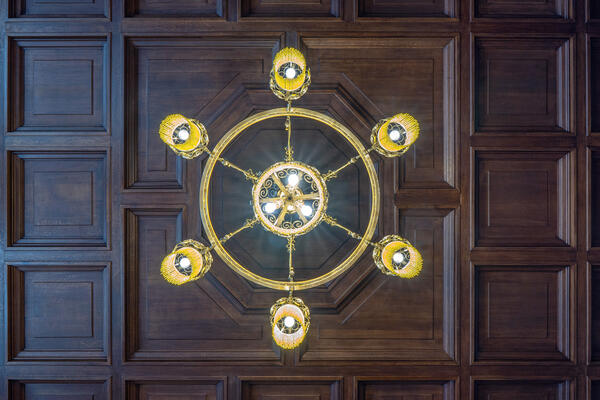This 12-light electric chandelier with a brass frame was designed exclusively for the Reception Room of Nicholas II at the Alexander Palace and is one of the unique pendant lights in the collection of the museum.
The interior of the Reception Room (originally the Dining Room) was decorated by the Russian artist and architect Roman Melzer, a supplier to the imperial court under Emperor Alexander III. The work on the Reception Room lasted from 1895 to 1896. The architect chose the early Art Nouveau style: the walls and ceiling were covered with oak panels. “Ө. Melzer & Co.” made a new set of furniture upholstered in green leather. This is where they commissioned a spectacular chandelier in the form of a suspended openwork frame on six chains with hemispherical lamps, decorated with pendants of yellow glass beads.
At the turn of the 20th century, lighting fixtures decorated with glass ornaments of various shapes — thin tubes, small beads, crystals or beads — came into fashion; they looked like a fringe. Pendant luminaires with a source of light directed downwards only became possible with the advent of electric lighting: unlike candles, the bulbs did not need to be in a strictly vertical position and could be turned in different directions.
Among the candle and bulb chandeliers of the Alexander Palace, created in the 18th and 19th centuries and later electrified, the one from the Reception Room is the only one that represents its time. The story of this unique piece is also worth mentioning. During the Second World War, the chandelier was evacuated to the city of Sarapul in the Udmurt Region. Shortly after its return to Leningrad in 1946, it was placed again in the Reception Room of Nicholas II in time for the opening of an Alexander Pushkin jubilee exhibition in the halls of the Alexander Palace.
In 2015, the chandelier briefly left its home again: restorers did some cleaning work on the metal surface, added the lost beads, and installed new electrical wiring.
The interior of the Reception Room (originally the Dining Room) was decorated by the Russian artist and architect Roman Melzer, a supplier to the imperial court under Emperor Alexander III. The work on the Reception Room lasted from 1895 to 1896. The architect chose the early Art Nouveau style: the walls and ceiling were covered with oak panels. “Ө. Melzer & Co.” made a new set of furniture upholstered in green leather. This is where they commissioned a spectacular chandelier in the form of a suspended openwork frame on six chains with hemispherical lamps, decorated with pendants of yellow glass beads.
At the turn of the 20th century, lighting fixtures decorated with glass ornaments of various shapes — thin tubes, small beads, crystals or beads — came into fashion; they looked like a fringe. Pendant luminaires with a source of light directed downwards only became possible with the advent of electric lighting: unlike candles, the bulbs did not need to be in a strictly vertical position and could be turned in different directions.
Among the candle and bulb chandeliers of the Alexander Palace, created in the 18th and 19th centuries and later electrified, the one from the Reception Room is the only one that represents its time. The story of this unique piece is also worth mentioning. During the Second World War, the chandelier was evacuated to the city of Sarapul in the Udmurt Region. Shortly after its return to Leningrad in 1946, it was placed again in the Reception Room of Nicholas II in time for the opening of an Alexander Pushkin jubilee exhibition in the halls of the Alexander Palace.
In 2015, the chandelier briefly left its home again: restorers did some cleaning work on the metal surface, added the lost beads, and installed new electrical wiring.



